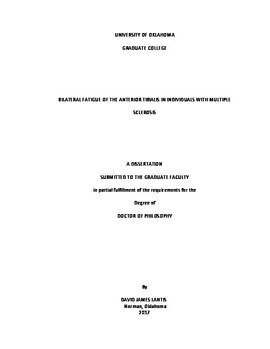| dc.contributor.advisor | Larson, Rebecca | |
| dc.contributor.author | Lantis, David | |
| dc.date.accessioned | 2017-07-27T16:53:35Z | |
| dc.date.available | 2017-07-27T16:53:35Z | |
| dc.date.issued | 2017-08 | |
| dc.identifier.uri | https://hdl.handle.net/11244/51846 | |
| dc.description.abstract | Multiple sclerosis (MS) is one of the most common progressive neurological diseases in young adults and is characterized by neurologic disruption within the central nervous system. Fatigue has been reported as one of the most debilitating symptoms in MS patients. Due to limited ankle mobility in MS patients during walking, investigating potential relationships between dorsiflexion strength asymmetry (SA) and walking ability is necessary to better understand the impact on quality of life in MS patients. PURPOSE: To investigate bilateral differences in strength and fatigability during isometric/isokinetic dorsiflexion in MS patients, and determine the relationship between SA and functional performance. Methods: 13 MS patients (MS Group: 8 females, 5 males) and 13 individuals without MS (NON-MS: 8 females, 5 males) participated in the current study. Maximal isometric and isokinetic contractions were conducted to determine peak torque (PT) and other muscle performance variables (voluntary contraction time (VCT), time-rate of muscle tension development (TRTD), and muscle tension-maintaining capacity (MTMC)). Subjects also performed fatiguing isometric and isokinetic exercise on separate days, and fatigability recovery was measured to investigate the effect of fatigue on PT and the muscle performance variables. Functional performance tests were conducted determine the relationship between isometric/isokinetic SA and walking ability. RESULTS: The MS group exhibited significant limb-limb PT differences during isometric (p = 0.01) and all isokinetic contraction speeds (p < 0.02) maximal contractions. The MS group also exhibited significantly greater SA than the NON-MS group (p = 0.03). There were no significant limb-limb differences or between group differences during the fatiguing tests. There were significant limb differences in PT before the isometric and isokinetic fatigue tests (p = 0.03, < 0.001 respectively) and after two minutes of recovery (p = 0.04, 0.002 respectively) in the MS group. The MS group exhibited lower performance in the functional performance tests, and there was a strong relationship between isometric/isokinetic SA and walking ability. CONCLUSION: There are no bilateral differences in fatigability in MS patients; however there are bilateral strength differences in dorsiflexion PT in MS patients. Dorsiflexion SA in MS patients is greater than in individuals without MS, and the dorsiflexion SA in MS patients has a strong relationship with walking performance. | en_US |
| dc.language | en_US | en_US |
| dc.subject | Multiple Sclerosis | en_US |
| dc.subject | Fatigue | en_US |
| dc.subject | Asymmetry | en_US |
| dc.subject | Exercise | en_US |
| dc.title | Bilateral Fatigue of the Anterior Tibialis in Individuals with Multiple Sclerosis | en_US |
| dc.contributor.committeeMember | Bemben, Debra | |
| dc.contributor.committeeMember | Black, Christopher | |
| dc.contributor.committeeMember | Larson, Daniel | |
| dc.contributor.committeeMember | Williams, T.H. Lee | |
| dc.date.manuscript | 2017-07-20 | |
| dc.thesis.degree | Ph.D. | en_US |
| ou.group | College of Arts and Sciences::Department of Health and Exercise Science | en_US |
| shareok.orcid | 0000-0001-5551-121X | en_US |
| shareok.nativefileaccess | restricted | en_US |
